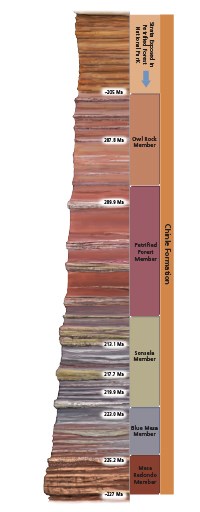
Erosion has sculpted and shaped intriguing landforms. The rocks reveal an enthralling chronicle of time that is unfolding and ever-changing. What can the rocks tell us? Think of the colorful layers as pages in a massive book.The first chapter of this geological text is the Chinle Formation.
Chinle Formation The Chinle Formation was deposited over 200 million years ago during the Late Triassic Period. The colorful badland hills, flat-topped mesas, and sculptured buttes of the Painted Desert are primarily made up of the Chinle Formation, mainly fluvial (river related) deposits. Within Petrified Forest National Park, the Chinle Formation is further divided to include the Blue Mesa Member, the Sonsela Member, the Petrified Forest Member, and the Owl Rock Member.
Geological Layers, Youngest to Oldest
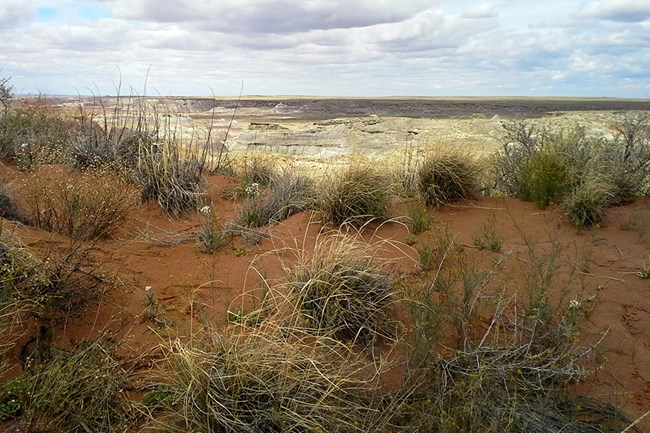
NPS Pleistocene and Holocene Epoch (1.8 million years ago to present) deposits of windblown sand and alluvium (deposited by flowing water), now cover much of the older formations of the park. At higher elevations in the northern part of the park, 500,000-year-old dunes can be found. Younger dunes, around 10,000 years old, are found in drainage areas that contain sand such as Lithodendron Wash. The youngest dunes are found throughout the park, in all settings, deposited around a thousand years ago. These dune deposits are largely stabilized by vegetation, especially grasses. While not as numerous as the fossils of the Chinle Formation, fossils have been found even in the quaternary sediments, including fragments of an ancestral proboscidean (elephants and their relatives, such as mammoths). The Little Colorado River and its tributaries, including the Puerco River, have cut their own valleys into the soft Chinle and Bidahochi Formations of the Painted Desert. 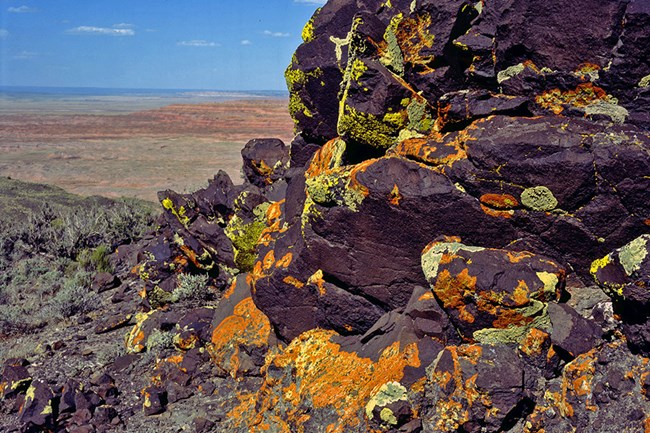
NPS During the Late Miocene and Early Pliocene Epochs of the Neogene Period (4-8 million years ago) a large lake basin with ephemeral lakes covered much of Northeastern Arizona. Fine-grained fluvial and lacustrine (lake related) sediment such as silt, clay, and sand represent the lower part of the Bidahochi Formation. Volcanoes, both nearby and as far as the Southwestern Nevada Volcanic field, spewed ash and lava over the land and into the basin. Many of the volcanoes were phreatomagmatic, when ground or lake-water mingled with eruptive material (magma) to cause explosive eruptions. The resulting ash formed fine-grained deposits that were deposited within the lake sediments. After a few million years of erosion, most of the Bidahochi Formation has been removed from the park area, leaving volcanic scoria cones and maars (flat-bottom, roughly circular volcanic craters of explosive origin). The vent from one of these maars is exposed on the Painted Desert Rim across the park road to the east of Pintado Point. The Hopi Butte Volcanic Field, which can be seen from the northern overlooks of the park extending northwest, is considered one of the largest concentrations of maar landforms in the world, covering about 965 square miles (2,500 square km). The erosion-resistant lava flows, such as Pilot Rock and the Hopi Buttes, protect the softer lake-bed deposits beneath. 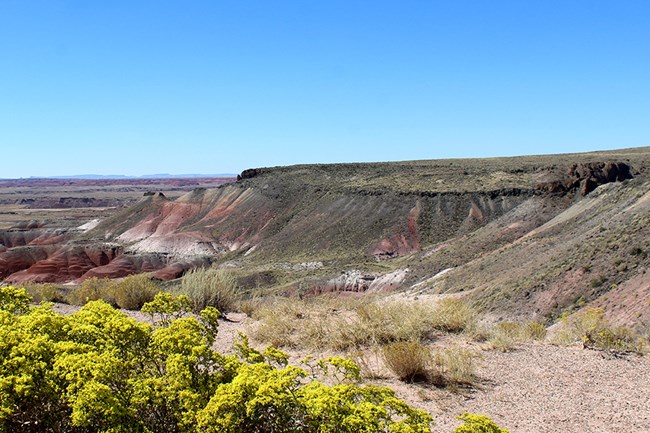
NPS 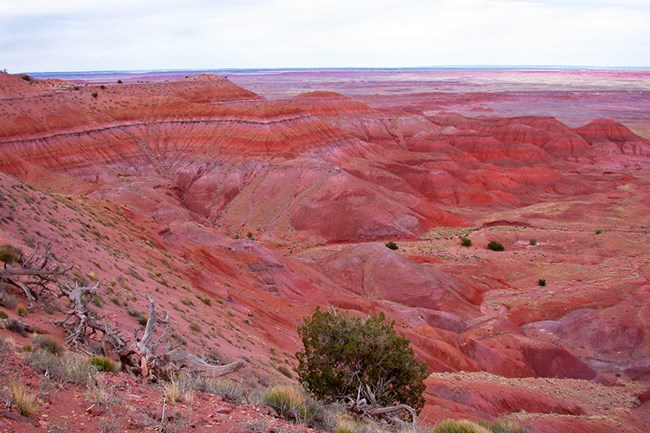
NPS The colorful layers in the Chinle Formation represent ancient soil horizons. The coloration is due to the presence of various minerals. While the red and green layers generally contain the same amount of iron and manganese, differences in color depend on the position of the groundwater table when the ancient soils were formed. In soils where the water table was high, a reducing environment existed due to a lack of oxygen in the sediments, giving the iron minerals in the soil a greenish or bluish hue. The reddish soils were formed where the water table fluctuated, allowing the iron minerals to oxidize (rust). 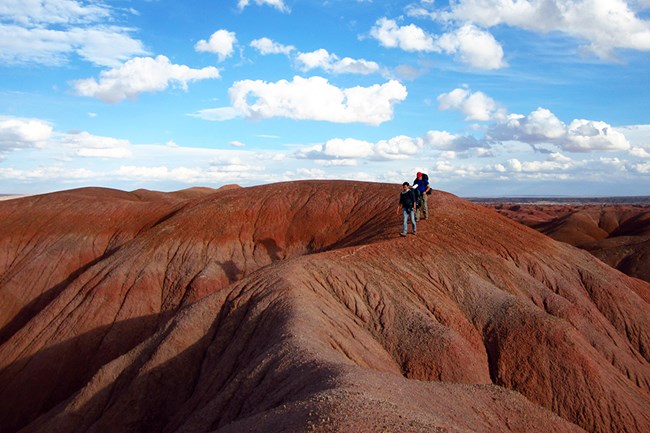
NPS 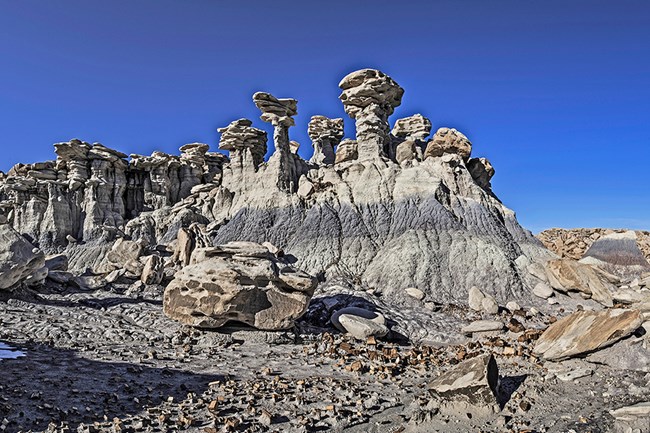
NPS/Andrew V. Kearns 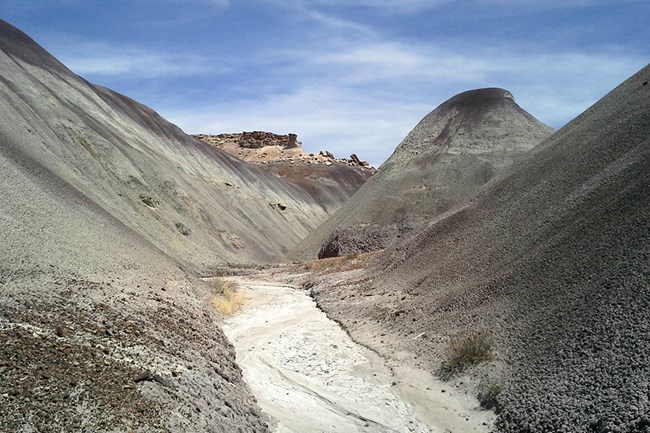
NPS 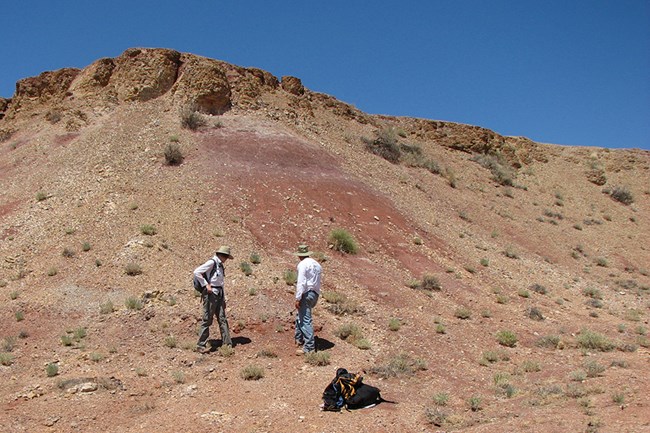
NPS
The Mesa Redondo Member is the oldest member of the Chinle Formation exposed in the Petrified Forest, mainly in the Tepees area. The Mesa Redondo consists of dark red siltstones as well as sandy conglomerates. The top of the member is very colorful hard layer with yellow, red, and purple mottles. The Mesa Redondo was deposited between 225-227 Million years ago and represents floodplain deposits that were adjacent to the sandstone channels of the Shinarump Member. 
NPS |
Last updated: September 13, 2020
